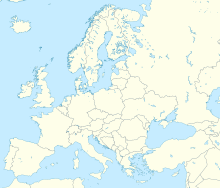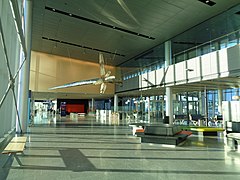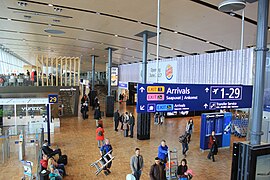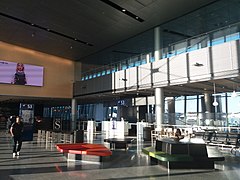
A | B | C | D | E | F | G | H | CH | I | J | K | L | M | N | O | P | Q | R | S | T | U | V | W | X | Y | Z | 0 | 1 | 2 | 3 | 4 | 5 | 6 | 7 | 8 | 9
Helsinki-Vantaa Airport Helsinki-Vantaan lentoasema Helsingfors-Vanda flygplats | |||||||||||||||||||
|---|---|---|---|---|---|---|---|---|---|---|---|---|---|---|---|---|---|---|---|
 | |||||||||||||||||||
| Summary | |||||||||||||||||||
| Airport type | Public | ||||||||||||||||||
| Owner/Operator | Finavia | ||||||||||||||||||
| Serves | Helsinki metropolitan area | ||||||||||||||||||
| Location | Aviapolis, Vantaa, Finland | ||||||||||||||||||
| Opened | July 1952 | ||||||||||||||||||
| Hub for | |||||||||||||||||||
| Elevation AMSL | 55 m / 179 ft | ||||||||||||||||||
| Coordinates | 60°19′02″N 024°57′48″E / 60.31722°N 24.96333°E | ||||||||||||||||||
| Website | www | ||||||||||||||||||
| Map | |||||||||||||||||||
| Runways | |||||||||||||||||||
| |||||||||||||||||||
| Helipads | |||||||||||||||||||
| |||||||||||||||||||
| Statistics (2023) | |||||||||||||||||||
| |||||||||||||||||||
Source: Finavia | |||||||||||||||||||
Helsinki-Vantaa Airport (Finnish: Helsinki-Vantaan lentoasema, Swedish: Helsingfors-Vanda flygplats)[1] (IATA: HEL, ICAO: EFHK), or simply Helsinki Airport, is the main international airport serving Helsinki, the capital of Finland, as well as its surrounding metropolitan area, and the Uusimaa region in Finland. The airport is located in the neighbouring city of Vantaa, about 5 kilometres (3 mi) west of Tikkurila, the administrative centre of Vantaa and 9.2 NM (17.0 km; 10.6 mi) north[1] of Helsinki's city centre. The airport is operated by state-owned Finavia.[2] The facility covers a total of 1,800 hectares (4,448 acres) of land and contains three runways.[3]
The airport is by far the busiest in Finland (with 20 times the traffic of the next-busiest, Oulu) and the fourth busiest in the Nordic countries in terms of passenger numbers. About 90% of Finland's international air traffic passes through Helsinki Airport.[4] In 2022, Helsinki Airport had a total of 12.9 million passengers, 87% of whom were international passengers and 13% domestic passengers.[5] On average, the airport handles around 350 departures a day.[4]
The airport is the main hub for Finnair, the flag carrier of Finland, and its subsidiary Nordic Regional Airlines. It is also a hub for CityJet (on behalf of SAS) and an operating base for Jettime, Norwegian Air Shuttle, Sunclass Airlines and TUI fly Nordic. Helsinki Airport has around 50 regularly-operating airlines. The airport has around 80 scheduled destinations to other parts of Europe and 21 direct long-haul routes to Asia, the Middle East, and North America. There are also 35 charter destinations including numerous long-haul charter destinations.[6][7]
Originally built for the 1952 Summer Olympics in Helsinki, the airport today provides jobs for 25,000 people and there are 1,500 companies that operate at this airport.[8][9]
Finavia aims to strengthen the position of Helsinki Airport in transit passenger traffic between Europe and Asia, and to increase the number of direct connections to Europe.[10] Helsinki Airport's minimum transit time of 35 minutes is among the shortest in Europe.[11] According to Finavia's survey, as many as one in every three passengers select their flight route based on the transit airport.[12]
History
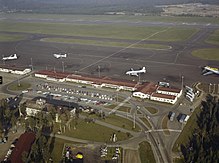



Opening and the first intercontinental service (1952–1960s)
The planning of a new airport for Helsinki began in the 1940s, when it became obvious that the Helsinki-Malmi Airport could not handle the increasing number of passengers or the new, heavier aircraft. A new site was found some 20 km (12 mi) from Helsinki city centre, in an area that today belongs to the city of Vantaa (until 1971 Vantaa was called Helsingin maalaiskunta). Some of the construction work was done by prison laborers.[13] The airport opened temporarily in July 1952 for that year's Summer Olympics, held in Helsinki.[14]
The first two Aero Oy DC-3 aircraft, OH-LCC Tiira with its captain Olli Puhakka and first officer Pertti Uuksulainen, and OH-LCD Lokki, landed in Vantaa on 26 June 1952, and the first scheduled international airplane to land on the airport was the DC-6 B Torgil Viking of Scandinavian Airlines on 26 October 1952. While Aero (now Finnair) used Helsinki-Malmi Airport, charter flights were directed to the new airport on 26 October 1952. The airport originally had a single runway, the second runway being built four years later in 1956, and the first airplane hangar was also built in the same year. The airport also received its first radar in the same year.[13] Regular jet flight operations began in 1959.
A new passenger terminal opened in 1969, while the first transatlantic service to New York was inaugurated on 15 May 1969. A contiguous fence around the entire airport area was built in spring 1973.[15]
During this time period, the airport was also called Seutula Airport after the nearby village Seutula.[16][17]
New terminal and first Asian flights (1970s–1990s)
The year 1973 saw the first security checks being carried out for international flights. The name Helsinki-Vantaa Airport was used from 1977, with the airport being known as the Helsinki Airport before this.[18] The postal code of the airport was 01530 Helsinki-Lento until 1974, 01530 Helsinki-Vantaa-Lento from 1974 to 1983 and 01530 Vantaa from 1983 onwards.
The Finnish Defence Forces surrounded the airport in late autumn 1977, in order to protect the airport from a possible terrorist strike by the Red Army Faction.[19]
In 1983, the airport began offering the first non-stop service from Western Europe to Japan as Finnair commenced regular service between Helsinki and Tokyo with a single McDonnell Douglas DC-10-30ER. In the 1970s, Pan Am operated flights from Helsinki to the US. The passenger terminal was expanded for the first time in 1983 and five years later, in 1988, the airport handled over six million passengers annually.[citation needed]
In 1991, Delta Air Lines began its operations at the airport. A new terminal was constructed for domestic flights in 1993. In 1996, the international terminal was expanded and merged with the domestic terminal. At the same time, the new control tower was completed. In 1997, a new VIP President terminal was opened for official international state visits. In November 1999, the international terminal was further expanded and the lobby for arriving and departing passengers was built.
New millennium and expansion of non-Schengen area (2000–2009)
A historical event in 2000 was that the annual number of visitors to the Helsinki-Vantaa Airport surpassed 10 million.[20] Approach traffic control moved from the so-called "cave" into its new overground premises.
New border controls of the Schengen Agreement were taken into use in 2001. The third runway was inaugurated on 28 November 2002 and the first user was Finnair's McDonnell Douglas MD-11 en route to New York. In 2004, the international terminal was again expanded and a new shopping area was opened for long-haul passengers. A new air cargo service was opened for passengers with overweight luggage. 24 new automatic check-in terminals were taken into use in 2006.[21]
On 13 August 2007 a new Hilton hotel, Hilton Helsinki-Vantaa Airport was opened near the airport, with 330 rooms.[22][23] Independent use of parallel runways started in November 2007.[24]
A free-of-charge WLAN network was opened at the airport on 25 November 2008.[25]
In autumn 2009, the airport saw a great deal of industrial action, as Finavia outsourced check-in security controls. The security controls were moved over to the cleaning and building service concern SOL. The labour agreements also changed. SOL started co-operation negotiations for 80 employees in January 2010. Outsourcing the security services had a positive impact on Finavia's economy, as this allowed the company to reach significant cost savings during the first half of 2010 compared to the second half of the previous year. This was largely because of the outsourcing of the security services at the Helsinki Airport.[26] In late 2012, the Labour Court of Finland gave a statement that the security services at the airport were under the labour agreement of the security guard industry. After this, SOL terminated its contract, to end at the end of 2014 in the middle of its contract period.[27]
Finnair outsourced its baggage handling services from its daughter company Northport to Barona Handling in November to December 2009, after which the baggage handling employees went on an illegal strike for four days. During New Year from 2009 to 2010 thousands of bags lay untouched at the airport, inaccessible to their owners. According to the employees, there were one tenth less people handling the loading of the baggage than before. The Aviation Union accused Barona of neglecting safety regulations when unloading the accumulated pile of baggage during the industrial action.[28] In January 2010 the Finnish News Agency wrote that some of the employees had sent baggage to the wrong destination on purpose.[29][30][31] In 2009, the airport dropped out of the list of the Airport Service Quality research.[32]
In 2009, an expansion of Terminal 2 was completed. The total floor area was 43,908 square metres (472,620 sq ft). The same year witnessed the opening of a new shopping area and spa for passengers on long-haul flights, the removal of a terminal-specific division between domestic and international flights in favour a division by airline, and the renovation of Terminal 1 for international flights.[33] In the same year, TAP Air Portugal commenced service between Helsinki and Lisbon.
Five new passenger bridges for wide-body aircraft were opened in 2009. The spa was closed down in 2012 because of lack of use.[34] In 2011 the annual number of passengers at the airport grew by 15.5% to 14.9 million passengers. About 25% of passengers were transferring to a connecting flight at the airport. 12.2 million passengers were on international flights and 2.7 million on domestic flights. A total of 1.63 million passengers were on flights to Asia.[35]
Significant growth and expansion (2010–present)
During the 2010s, Helsinki Airport experienced large increases in the number of annual passengers. In 2010, the airport handled 12,883,399 passengers, an increase of 2.2 percent compared to 2009. Air freight increased by 29.4 percent.
In April 2010, Norwegian Air Shuttle opened its first routes to Oslo and Stockholm using Boeing 737 jets. Now the airline is one of the largest operators at the airport with almost 40 destinations in Europe, Asia, and Africa. In 2011, Helsinki Airport saw its biggest growth in a single year in the number of passengers. The number of annual passengers was increased by 2 million passengers and the airport reached the milestone of 14 million passengers. However, easyJet canceled three routes, from Helsinki to Manchester, London–Gatwick, and Paris–Charles de Gaulle, citing weak demand at Helsinki.[36]
In November 2011, Austrian Airlines canceled its Vienna–Helsinki operations. In the same year, Czech Airlines ceased its Helsinki operations due to low demand.[citation needed] A year after, LOT Polish Airlines canceled its service to Helsinki. In 2014, a number of airlines such as Aer Lingus, Germanwings, and S7 Airlines canceled services to Helsinki.[citation needed]
In the 2010s, the airport saw a huge growth of long-haul flights in terms of weekly flights (see Long-haul traffic below).
In the beginning of 2015, the renovation and construction work related to the development of Helsinki Airport started. For example, the Baggage Claim Hall 2B and Arrival Hall 2A were renovated and in July 2015, train operation on the Ring Rail Line and connection to Helsinki Central Railway Station were opened. In March 2015, Swiss International Air Lines started operations to Helsinki but canceled it a year later. In late 2015, Blue1 ceased all operations from Helsinki which was the airline's only base. The airline flew to 28 destinations in Europe. Scandinavian Airlines sold Blue1 to CityJet, which continues to operate the company on behalf of SAS as part of a larger relationship.[37] In 2015, the airport handled up to 16 million passengers for the first time. In March 2016, Czech Airlines resumed flights from Prague to Helsinki using Airbus A319 aircraft. On 10 October 2016, the first Gulf carrier Qatar Airways began operations at the airport and now operates to Helsinki by Boeing 787 Dreamliner. The carrier was initially planning to launch the service as early as 2012. Finavia expects that the airport will handle over 18.5 million passengers in 2017 and around 20 million in 2018, or in 2019 at the latest.[citation needed] Also in 2017, the airport experienced huge growth in numbers of passengers flying intercontinental.[citation needed]
As of 2013, Finavia has been expanding the airport (see Future expansion below).
Life in HEL (#lifeinhel) was a Finavia marketing campaign which took place from 10 October to 9 November 2017 at Helsinki Airport. The campaign mixed TV, game shows, and social media. Ryan Zhu, a Chinese actor and TV personality, lived in a little cabin inside Helsinki Airport for 30 days. Helsinki Airport was awarded the title of best airport in the world by Travellink; by the campaign, Finavia wanted to prove this claim.[38]
A free-of-charge film theatre named Airport Cinema was opened near gate 33 in November 2018.[39]
A new terminal expansion was opened in 2012. The terminals 1 and 2 were combined on 21 June 2022 so that all flights are now operated from a single terminal.[40][41]
Construction projects
In spring 2010 a new baggage handling centre utilising the latest technology was taken into use at the airport, concentrating all handling of departing and transferring baggage. Handling of arriving baggage remains at its current handling facility.[citation needed]
The parts of the airport that were completed in 1969 and 1983 were thoroughly renovated. Basic repairs were completed in 2012.[citation needed]
Runway 3 (22R/04L) was repaired from April to June 2012, during which time the runway was out of use. After this the taxiway next to runway 2 (15/33) was repaired, during which time runway 2 served as a temporary taxiway. The repairs were completed in September 2012.[42]
The main runway 04R/22L was repaired in summer 2015 and was reopened in early August.[43]
The Helsinki Airport station was opened on 10 July 2015.[44] The Ring Rail Line connects the Helsinki–Riihimäki railway in the north with the Vantaankoski railway in the west. The trip from the airport to the Helsinki Central station takes about half an hour, and the trip to Tikkurila railway station takes about ten minutes. The Helsinki Airport station was built underground between the parking garages P3A and P1/P2. The station has a walking connection to the connecting corridor between terminals 1 and 2.
Expansion of the terminals started in early 2016 from the southern wing of the long-distance flight area, which was completed in summer 2017. After this, construction of the western wing was started, which was completed in autumn 2019.[45] Expansion of terminal 1 was also started in 2017, giving the terminal an additional 3,500 square metres of floor area.[46] Terminal 1 was lengthened by 230 metres and gained seven new departure gates.[47]
As part of the development program, a new parking garage was also opened, with a connection to the terminal. The new parking garage is equipped with solar panels, and it has an area for recharging 200 electric cars. The development program also included about 2000 new parking places.
Expansion of the terminal is undergoing to the north of the terminal building, including expansion of the number of commercial services, gates and docks for airplanes. The expansion also includes improvement of passenger connections to the terminal. The expansion was taken into use in late 2021.
The undergoing development program is scheduled to be completed in 2023. Before this, new lobbies for departing and arriving passengers and a connecting travel centre were taken into use. Also the old departure lobby of Terminal 2 will be changed into part of the Schengen gate area, expanding the size of the area considerably.
During New Year 2020 to 2021 a three-year repair project of the station level was completed, not included in the development program. The purpose of the repair project, which cost 32 million euro, is to ensure the safety of taxiing and parking the airplanes and to improve the capacity and effectiveness of air traffic. The infrastructure of the station level will be modernised, allowing a further decrease of environmental impacts of air traffic.[citation needed]
A two-part Avia Pilot building with 13 floors was built within walking distance of the terminal, with Finavia as its main tenant.[48] In early 2018 a new Scandic Hotels hotel with 148 rooms was opened in the building. This is the third hotel in the immediate vicinity of the airport.[49]
Interior gallery
-
The old departure check-in area in Terminal 2
-
The gate area in the terminal
-
Expansion of the terminal
-
A café at the airport
-
The new arrivals hall
-
The new departures hall
Composition
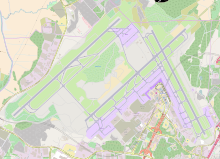
The airport has one terminal. The terminal capacity of the airport is approximately 16–17 million passengers per year.[50]
Domestic flights, as well as flights to European Schengen countries, are operated from gates 11–34. Long-haul and European non-Schengen flights are operated from gates 34–55.[51]
In 2014, Helsinki Airport introduced the world's first passenger tracking system,[52] which automatically monitors crowd congestion and prevents bottlenecks at the airport.[52]
The airport's signage is in English, Finnish, Swedish, Korean, Chinese, Japanese, and Russian.
Current terminal (former Terminal 2) opened in 1969 for international operations and, at present, also serves domestic flights. The non-Schengen area of the terminal was enlarged in 2009 enabling the airport to accommodate eight wide-body aircraft at gates simultaneously while a new shopping area and a spa were opened for passengers on long-distance flights, and the division between domestic and international flights was removed. Terminal 2 has many restaurants, bars and shopping areas. The terminal is equipped with 26 aircraft parking stands with passenger bridges. The terminal has a train connection to Helsinki Central railway station.
Passenger facilities include numerous tax-free shops, Avis, Europcar and Hertz-car rentals, free wireless Internet access, power sockets, lockers, sleeping pods and transfer service desks. Currency exchange, cash machines (ATM), tourist information and an Alepa grocery store and pharmacy are also available. For children, there are also several playrooms. Dining facilities include Burger King and O'Learys Sports Bar as well as numerous other restaurants and cafés. Terminal 2 also includes two Finnair lounges: Finnair Lounge in the Schengen-area and Finnair Premium Lounge in the non-Schengen area.
As a part of Helsinki Airport's expansion plan, the new South Pier was inaugurated in June 2017 and Aukio in February 2019. The new pier features moving walkways and dual boarding jet bridges to enable handling larger aircraft more efficiently. In November 2019, the West Pier opened and it is able to accommodate the Airbus A380 superjumbo. Five of the gates are able to accommodate two regional jets, such as Boeing 737s or Airbus A320s, simultaneously at a single gate.[53] Passengers arriving and departing are divided into two floors: one for arriving passengers, the other for departures. In June 2016, the new bus terminal for remote aircraft stand operations was opened to increase the airport's capacity with gates 50A-M.
-
New terminal entrance
-
New departure hall
-
Old exterior of Terminal 2
-
The interior of the terminal
-
The restaurant area in the terminal
-
Finnair's former check-in area
-
The gate area of the new South Pier of non-Schengen area
-
The new South Pier of non-Schengen area
Other buildings

There are several airport hotels and office buildings on the grounds of the airport. The Aviapolis is a new international business park adjacent to the Helsinki airport area, already hosting the operations of numerous companies around the airport. In 2013, Finnair opened its new head office, known as House of Travel and Transportation, or "HOTT". The construction of HOTT began in July 2011 and finished on time in June 2013.
Ground handling
Airpro, Aviator, and Swissport provide ground handling services for airlines.
Runways

Helsinki Airport has three runways. The runways can handle take-offs and landings of the heaviest aircraft in use today such as the Airbus A380. The use of three runways allows two runways to be kept in operation when clearing of snow and ice is needed (if one runway is being cleared at a time).[54][55]
| Number | Runway direction/code |
Length (in metres and feet) |
ILS[56] | Surface | Notes |
|---|---|---|---|---|---|
| 1 | 04R/22L | 3,500 m 11,483 ft |
Cat. II (both directions) |
Asphalt | The first runway at the airport |
| 2 | 15/33 | 2,901 m 9,518 ft |
Cat. I (15) |
Asphalt | 15 used for propeller and low visibility departures. 33 only used during strong winds from NW. |
| 3 | 04L/22R | 3,060 m 10,039 ft |
Cat. III (04L) |
Asphalt | Inaugurated on 28 November 2002 |
Text je dostupný za podmienok Creative Commons Attribution/Share-Alike License 3.0 Unported; prípadne za ďalších podmienok. Podrobnejšie informácie nájdete na stránke Podmienky použitia.
Antropológia
Aplikované vedy
Bibliometria
Dejiny vedy
Encyklopédie
Filozofia vedy
Forenzné vedy
Humanitné vedy
Knižničná veda
Kryogenika
Kryptológia
Kulturológia
Literárna veda
Medzidisciplinárne oblasti
Metódy kvantitatívnej analýzy
Metavedy
Metodika
Text je dostupný za podmienok Creative
Commons Attribution/Share-Alike License 3.0 Unported; prípadne za ďalších
podmienok.
Podrobnejšie informácie nájdete na stránke Podmienky
použitia.
www.astronomia.sk | www.biologia.sk | www.botanika.sk | www.dejiny.sk | www.economy.sk | www.elektrotechnika.sk | www.estetika.sk | www.farmakologia.sk | www.filozofia.sk | Fyzika | www.futurologia.sk | www.genetika.sk | www.chemia.sk | www.lingvistika.sk | www.politologia.sk | www.psychologia.sk | www.sexuologia.sk | www.sociologia.sk | www.veda.sk I www.zoologia.sk



